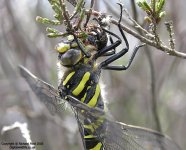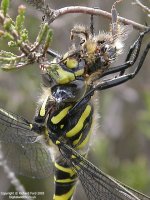Hi all
Thanks for the complements regarding my photos.
Photographing this insect was remarkably easy to be honest.
I first noticed the Golden-ringed Dragonfly
(Cordulegaster boltonii) cruising the small pond where several of my Odonata photos are taken. It was getting a lot of hassle from the Emperor Dragonflies
(Anax imperator) present but was clearly a bit bigger than they were. As it flew near to me I instantly realised what it was, (this was the first encounter I had had with the species). It flew past and down into the heather, I slowly approached the area and started firing shots from quiet a distance. The last thing I wanted was to come away with nothing, but it allowed me to approach rather close seeming uninterested in my presence and I noticed it was eating a small fly. It seemed to finish quickly and flew again this time staying around the heather and then landed. Once again I made my slow approach this time to discover it had a larger prey item, the bee in the photographs. It stayed put for several minutes allowing me to take photographs with the Coolpix 4500 at very close range less than 30cm away. This is my only encounter with this species to date so I am unaware how approachable they normally are, but it appeared so evolved in its meal that my presence was of no concern to it.
I have found this the case with mating Odonata too. I have a few shot of
mating Common Hawkers for example, they seem so involved in what they are doing

, they will allow an approach far closer than usual. It’s near impossible to photograph some of the males as they rarely seem to land but in some situations they are approachable.
Incidentally I had initially thought there was some damage to the eye of this insect in the above photo, having examined the before and after shots in the series It appears to be a peace of the bee, giving the illusion of a hole in the eye. I am not that familiar with the structure of their eyes, but to me it looked like it had been torn open.
All the best
Richard







